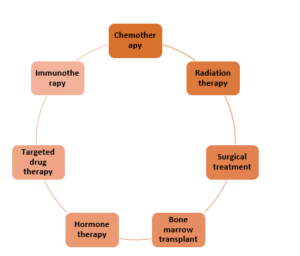India is known for its very innovative and successful cancer treatments in India. Some of the greatest cancer hospitals in the world are located in India. Advanced procedures are used in the hospital to treat patients from everywhere. These procedures are modern and can help anyone. India is famous for its excellent cancer care. They use modern research and the latest treatments to help patients. These hospitals serving the best cancer treatments rank among the best in India due to their cutting-edge facilities, highly skilled medical staff, and cutting-edge technology.
Why India is Best for Cancer Treatments
There are several reasons why India is considered the best for different cancer treatments.
- India is home to some of the top cancer treatment facilities and cutting-edge technologies, such as Cyberknife, proton beam therapy, and other cutting-edge choices. Rapid technological advancements in the Indian healthcare sector have made it possible for cancer doctors to offer specialized and individualized patient care for personalized therapy.
- Secondly, the availability of affordable cures and treatments makes India one of the greatest locations in the world for cancer treatment. When compared to other countries, cancer treatments, and medications are far less expensive, yet the standard of care is comparable.
- Thirdly, India is home to some of the world’s best cancer hospitals, particularly in major cities like Bangalore, Chennai, Mumbai, and Delhi. These hospitals are renowned for their medical proficiency in individualized and cutting-edge therapies and treatments. India is one of the most popular locations worldwide for cancer treatment because of its highly qualified and committed cancer surgeons and access to cutting-edge technologies.
Depending on the type of cancer and its location, a combination of the following therapies is given to an individual suffering from cancer. There are different types of Cancer Treatment such as:

Let’s get into details about the different types of cancer treatments that have been mentioned above.
Chemotherapy–
Chemotherapy may be used if cancer has spread or there’s a risk it will. It can be used to:
- cure cancer completely (curative chemotherapy)
- make other treatments more effective – for instance, it can be combined with radiotherapy (chemoradiation) or used before surgery (neo-adjuvant chemotherapy)
- reduce the risk of the cancer coming back after radiotherapy or surgery (adjuvant chemotherapy)
- relieve symptoms if a cure is not possible (palliative chemotherapy)
The most common types are:
- chemotherapy is given into a vein (intravenous chemotherapy) – this is usually done in the hospital and involves medicine being given through a tube in a vein in your hand, arm, or chest
- chemotherapy tablets (oral chemotherapy) – this usually involves taking a course of medicine at home, with regular check-ups in the hospital
Side-Effects of Chemotherapy:
- feeling tired most of the time
- feeling and being sick
- hair loss
- an increased risk of getting infections
- a sore mouth
- dry, sore, or itchy skin
- diarrhea or constipation
Radiation Therapy:
Radiation therapy (also called radiotherapy) is a cancer treatment that uses high doses of radiation to kill cancer cells and shrink tumors. In fact, in low doses, radiation is used in X-rays to see inside your body, as with X-rays of your teeth or broken bones.
Types of radiation therapy
There are two main types of radiation therapy, external beam and internal.
The type of radiation therapy that you may have depends on many factors, including:
- the type of cancer
- the size of the tumor
- the tumor’s location in the body
- how close the tumor is to normal tissues that are sensitive to radiation
- your general health and medical history
- whether you will have other types of cancer treatment
- other factors, such as your age and other medical conditions
Side-Effects of Radiation Therapy
There are various side effects of radiation therapy that need to be taken care of, or else the patent might face utter difficulties.
- Hair loss.
- Memory or concentration problems.
- Nausea and vomiting.
- Skin changes.
- Blurry vision.
Surgical Treatment-
Cancer surgery is an operation or procedure to take out a tumor and possibly some nearby tissue. It is the oldest kind of cancer treatment, and it still works well to treat many types of cancer today. Surgery may be open or minimally invasive.
- In open surgery, the surgeon makes a large incision and removes some of the tumor, some healthy tissue, and sometimes nearby lymph nodes.
- In minimally invasive surgery, the surgeon makes several small incisions, rather than making one large incision. In one of her small incisions, she inserts a long thin tube with a miniature camera. The camera projects images from inside the body onto a monitor, allowing the surgeon to see what he or she is doing.
Side-Effects of Surgical Treatment
- Pain- Most people will have pain in the part of the body post-operation. How much pain one feel will depend on the extent of the surgery, the part of the body where you had surgery, and how you feel pain.
- Infection- Infection is another problem that can happen after surgery. To help prevent infection, follow your nurse’s instructions about caring for the area where you had surgery. If you do develop an infection, your doctor can prescribe a medicine (called an antibiotic) to treat it.
Bone marrow transplant-
These transplants may use cells from your own body (autologous transplant) or a donor (allogeneic transplant). It can benefit people with a variety of both cancerous and noncancerous diseases, including Acute leukemia, Adrenoleukodystrophy, and others. It is used to provide new stem cells, which can help kill cancer cells directly.
Risks of Bone Marrow Transplant
The procedure is very risky and doubtful. Although, your risks depend on several factors, which include the disease or condition that caused the need for a transplant, the type of transplant, your age, and your overall health. The possible complications from a bone marrow transplant include:
- Graft-versus-host disease (a complication of allogeneic transplant only)
- Stem cell (graft) failure
- Organ damage
- Infections
- Cataracts
- Infertility
- New cancers
- Death
Immunotherapy-
Immunotherapy is a type of cancer treatment that helps your immune system fight cancer. The immune system helps your body fight infections and other diseases. It is made up of white blood cells and organs and tissues of the lymph system. Immunotherapy drugs have been approved to treat many types of cancer. However, immunotherapy is not yet as widely used as surgery, chemotherapy, or radiation therapy. There are several types of immunotherapies such as T-cell transfer therapy, monoclonal antibodies, treatment vaccines, and more that help to treat cancer to a great extent.
Side-effects of Immunotherapy
Immunotherapy can cause side effects, many of which happen when the immune system that has been revved up to act against cancer also acts against healthy cells and tissues in your body.
Hormone Therapy–
This particular cancer treatment slows or stops the growth of cancer that uses hormones to grow. It is used for two main reasons such as for treating cancer, or to ease the symptoms of the developing cancer cells. Additionally, when it is used with other treatments, it can make a tumor smaller before surgery or radiation therapy (called neoadjuvant therapy).
Side-Effects of Hormone Therapy
Hormone therapy affects to some extent the hormones of the body and as a result, there happens some sort of dysfunctionality. Some common side effects for men who receive hormone therapy for prostate cancer include:
- hot flashes
- loss of interest in or ability to have sex
- weakened bones
- diarrhea
- nausea
- enlarged and tender breasts
- fatigue
Targeted drug therapy-
Targeted therapy is a type of cancer treatment that specifically targets proteins that control how cancer cells grow, divide, and spread. The majority of the targeted therapies are either small-molecule drugs or monoclonal antibodies. Most types of this therapy help treat cancer by may be interfering with certain proteins that help tumors grow and spread throughout the body.
Side-Effects of Targeted Therapy
There are some serious side effects that develop after the application of targeted therapy. The side effects that you may have depend on the type of targeted therapy you receive and how your body reacts to it. The most common side effects of targeted therapy include diarrhea and liver problems. There are other effects as well such as:
- problems with blood clotting and wound healing
- high blood pressure
- fatigue
- mouth sores
- nail changes
- the loss of hair color
- skin problems, which might include rash or dry skin
Conclusion:
From the above article, it can be stated that cancer cases are increasing with each passing day. There are several treatments that are running on top of cancer disease. Treatments such as targeted therapy, immunotherapy, hormone therapy, bone marrow transplant, and several others help in preventing the disease.

